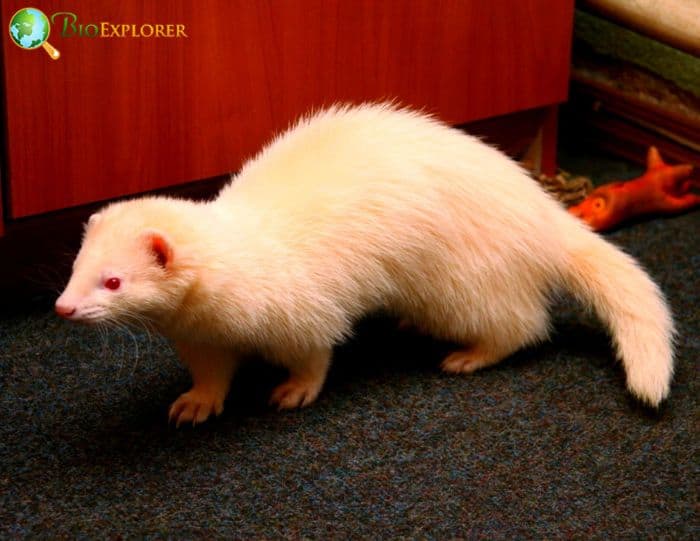
Albino Ferrets: Stepping into the captivating world of pets, a realm brims with an unparalleled sense of wonder and intrigue – the universe of ferrets. Sleek, playful, and curious, ferrets offer a unique blend of companionship and entertainment, a vibrant combination many pet lovers find irresistible.
Table of Contents
- Understanding Albino Ferret: An Overview
- Albino Ferret Genetics: The Science Behind The White Fur
- Characteristics of Albino Ferrets
- Caring for an Albino Ferret: A Comprehensive Guide
- Common Health Issues in Albino Ferrets
- Can You Own an Albino Ferret Everywhere?
- Albino Ferrets as Pets: Pros and Cons
- Adopting an Albino Ferret: Things to Consider
- Conclusion
Among these nimble creatures exists a breed shrouded in an air of mystery and fascination, Albino Ferret. Cloaked in a fresh coat of snowy white fur, Albino Ferrets are a testament to the enchanting spell of genetics. Their distinctive appearance, marked by their red or pink eyes gleaming like tiny rubies, sets them apart, evoking an aura of ethereal beauty. But their uniqueness extends beyond mere aesthetics.
In essence, Albino Ferrets are not just a different hue of the typical ferret – they are a testament to the rich tapestry of biodiversity, a chapter in the symphony of life that celebrates variance. Their unique genetic makeup manifests not just in their snow-white fur and crimson gaze but also in unique behaviors and health considerations that are all part of the comprehensive Albino Ferret package.
By delving deeper into the world of these beautiful creatures, we embark on a journey into a fascinating corner of nature’s spectrum. Welcome to the mesmerizing world of the Albino Ferret.
![]()
Understanding Albino Ferret: An Overview
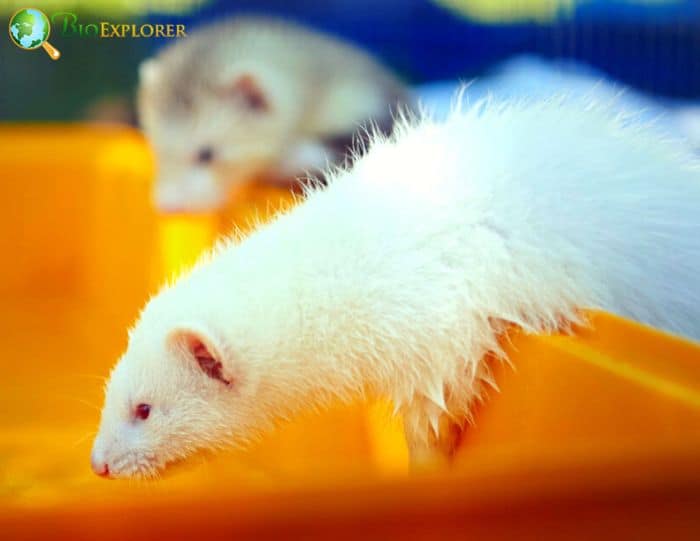
Embarking on a journey of understanding Albino Ferrets, we unveil a compelling narrative of these striking creatures, both in appearance and character.
Definition and Features of an Albino Ferret:
- Albino Ferrets are a special breed recognized by their distinctive white fur, a result of the absence of melanin, the pigment responsible for color in skin and fur.
- Their eyes, a captivating shade of red or pink, reflect light because of the absence of pigment. This striking feature is another tell-tale sign of their Albinism.
- Typically, they weigh between 1-4 lbs and measure 18-24 inches in length, a delightful size that fits snugly in the crook of an arm.
- Known for their vibrant energy and inquisitive nature, Albino Ferrets are as playful and agile as their non-albino counterparts.
Differences Between Albino Ferrets and Regular Ferrets:
- While regular ferrets come in various colors, from sable to chocolate, black to silver, Albino Ferrets are strictly white. Their albinism leads to their signature snowy-white fur and ruby-red eyes, features not seen in regular ferrets.
- Albino Ferrets have specific health considerations linked to their albinism. They may have increased sensitivity to light and higher susceptibility to certain skin conditions. These health nuances set them apart from regular ferrets.
While sharing the same playful disposition and charming curiosity, Albino Ferrets hold a unique standing regarding appearance and health factors in the ferret family. Each ferret, albino or otherwise, offers its exceptional blend of charm and companionship.
Albino Ferret Genetics: The Science Behind The White Fur
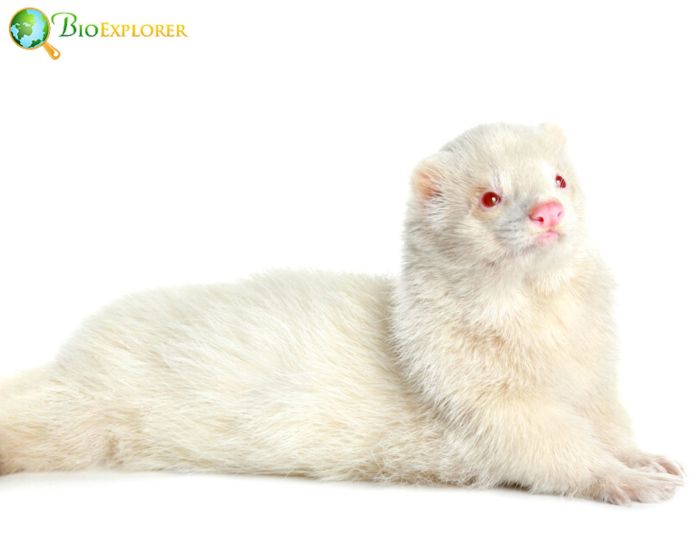
Unraveling the enigma that is the Albino Ferret, we find ourselves traversing the complex paths of genetics. This journey brings us closer to understanding the captivating aesthetics of these remarkable creatures.
Albinism and Genetics: An Introduction
- Albinism, as found in Albino Ferrets, is a genetic condition characterized by a marked deficiency or absence of melanin, a pigment responsible for animal coloration[1].
- This condition is typically inherited due to mutations in specific genes that influence melanin production.
Melanin: The Color Bringer
- Melanin, synthesized within cells called melanocytes, plays a crucial role in skin coloration, fur, and eyes.
- Melanin dictates various colors in ferrets with normal pigmentation, from deep sable to silver.
The Albino Mutation: A Closer Look
- In Albino Ferrets, a mutation in the tyrosinase gene, critical for melanin synthesis, leads to albinism. This gene is recessive, meaning an Albino Ferret must receive the gene from both parents to express the trait.
- The mutation interferes with melanin production, resulting in the trademark features of Albino Ferrets – the snow-white fur and the ruby-red eyes.
Implications of the Mutation
- The absence of melanin results in pure white fur, as the coat has no pigment.
- The red or pink hue of their eyes is due to the reflection of light from the blood vessels at the back of the eye. This happens because of a lack of melanin in the iris.
So, in the grand dance of DNA, the Albino Ferret waltzes to a unique tune. Its genetics, woven into an intricate pattern of genes and mutations, play out in its remarkable appearance, setting it apart in the diverse tapestry of the animal kingdom. Indeed, the Albino Ferret is a beautiful testament to the complex and fascinating world of genetics.
![]()
Characteristics of Albino Ferrets
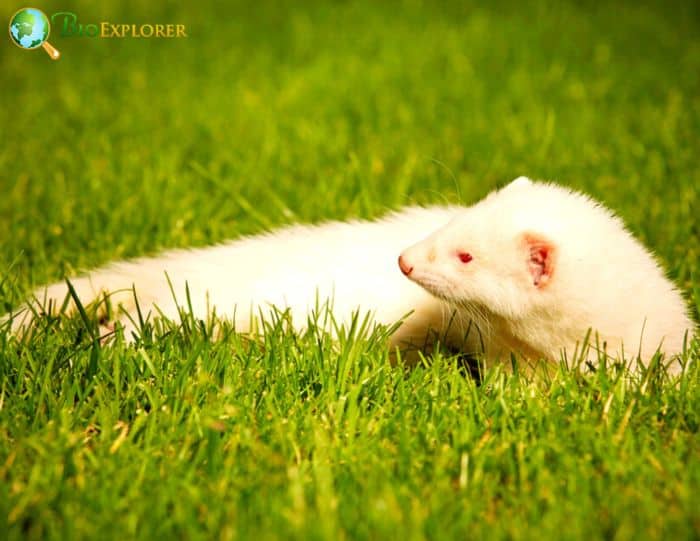
To fully appreciate the charm and allure of Albino Ferrets, one must take a closer look at their unique characteristics. Their intriguing physical features, vivacious personality traits, and distinct lifespan and health concerns make them a remarkable breed.
Physical Features:
- Albino Ferrets are adorned in a coat of pure white or cream, a stunning byproduct of their albinism. This pristine coat can shimmer with almost ethereal beauty.
- Their eyes, a captivating shade of red or pink, hold an almost mesmerizing quality. This color results from light reflecting off the blood vessels in their eyes due to the absence of melanin.
- On average, an Albino Ferret measures about 18 to 24 inches in length and weighs approximately 1 to 4 lbs, making them an ideal size for a petite, cuddly companion.
Personality Traits:
- Like their non-albino counterparts, Albino Ferrets are known for their vibrant energy and playful nature. Their curiosity often leads them into delightful antics that can amuse and entertain their human friends.
- Despite their active demeanor, they also cherish their sleep. They can spend much of the day dozing off in cozy corners.
Lifespan and Health Concerns:
- Albino Ferrets typically have a lifespan of around 7 to 10 years, given that they are cared for properly.
- They may exhibit a higher sensitivity to light due to the lack of melanin, making sun protection essential for these little critters.
- Their albinism may also predispose them to certain skin conditions. It may be prone to common ferret ailments like adrenal disease and insulinoma. Regular vet check-ups can help maintain their health.
In sum, Albino Ferrets are a bundle of joyous contradictions – their soft, serene appearance belying an effervescent personality, their small size hiding a big heart. They captivate with their physical attributes and endear with their spirited traits, making them a unique and engaging pet choice.
![]()
Caring for an Albino Ferret: A Comprehensive Guide
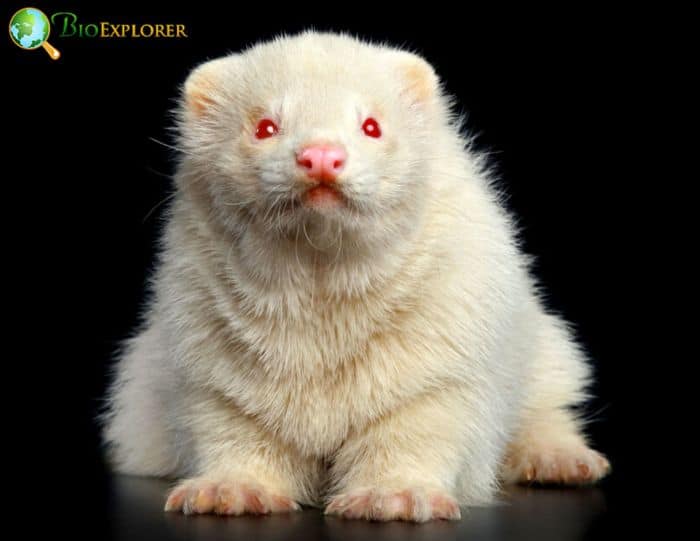
Regarding the proper care of an Albino Ferret, several key factors play pivotal roles. From their diet to exercise, grooming to housing, and medical care, each element contributes to their overall well-being, ensuring a happy and healthy life for these unique pets.
Proper Diet:
- Albino Ferrets are naturally carnivorous, requiring a diet high in animal protein and fat with minimal carbohydrates. Meals can include high-quality ferret food and small raw or cooked meat portions.
- Hydration is equally important, so always ensure your ferret has access to clean water.
Suggested Reading:
What Do Ferrets Eat?
Regular Exercise:
- These lively creatures thrive on activity and need ample time outside their cages to explore and play. A minimum of 3-4 hours of supervised daily playtime is recommended.
- Their inquisitive nature makes them susceptible to getting into places they shouldn’t, so a safe, ferret-proofed play area is essential.
Grooming Needs:
- Albino Ferrets, like all ferrets, are relatively clean animals. Regular but not overly frequent bathing (once a month or less) is adequate, as excessive bathing can dry their skin.
- Their nails need regular trimming, and their ears need cleaning every few weeks. Regular brushing can also help keep their coat healthy.
Housing Conditions:
- A spacious, well-ventilated cage with multiple levels is ideal for a ferret’s home. It should have enough room for separate sleeping, eating, and litter areas.
- The cage should be kept in a quiet, cool area, as Albino Ferrets are sensitive to high temperatures and bright light.
Medical Care:
- Regular vet visits are essential to maintain the health of your Albino Ferret. It’s important to find a vet with experience in caring for ferrets.
- Regular vaccinations and preventive treatments for parasites are crucial. Watch for signs of common ferret illnesses, such as adrenal disease and insulinoma.
- Remember that Albino Ferrets can have additional light sensitivity and potential skin issues related to their albinism. Discuss these concerns with your vet to ensure proper care.
Caring for an Albino Ferret involves understanding their unique needs and lifestyle. It’s a commitment of time, energy, and resources. However, the reward is a vibrant and loving companion who will surely bring joy and dynamism into your life. With the right care, these snow-white furballs can thrive and live out their years of health and happiness.
![]()
Common Health Issues in Albino Ferrets
Diving into the specific health concerns of Albino Ferrets, we find that while they generally share many of the common health problems with their non-albino counterparts, their albinism necessitates some additional attention to sight and skin issues.
![]()
Common Health Problems:
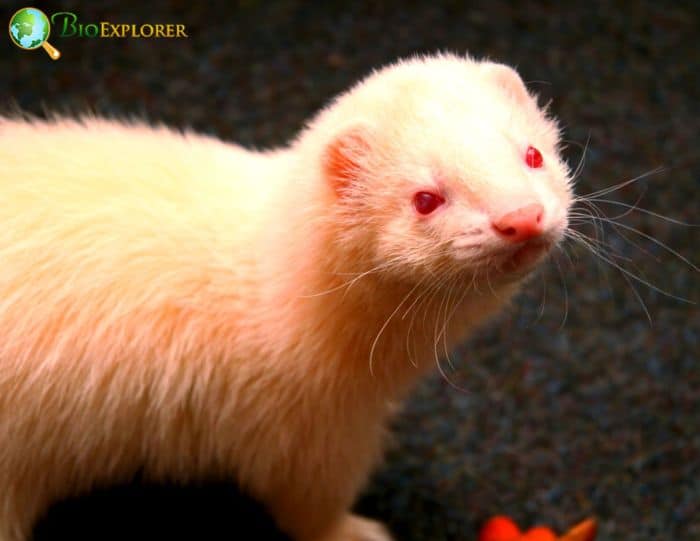
- Like all ferrets, Albinos are prone to certain health issues, such as adrenal disease, characterized by hair loss, itching, and swelling. They’re also susceptible to insulinoma, a condition marked by the growth of pancreatic tumors leading to low blood sugar levels.
- Lymphoma, heart disease, and gastrointestinal diseases are other conditions that Albino Ferrets may encounter during their lifespan.
Albinism-Related Issues:
- Albinism in ferrets can lead to heightened sensitivity to light, which can cause discomfort and potential damage to their eyes if exposed to bright light for extended periods. Therefore, ensuring their living environment is suitably lit is important.
- The absence of melanin could also make their skin more prone to sunburn and certain skin conditions. Regular check-ups and appropriate skin care can help monitor and manage these potential issues.
Awareness and understanding of these health issues can enable better care for Albino Ferrets. Early detection and prompt medical intervention are key to managing these conditions and ensuring a good quality of life for these unique pets.
![]()
Can You Own an Albino Ferret Everywhere?
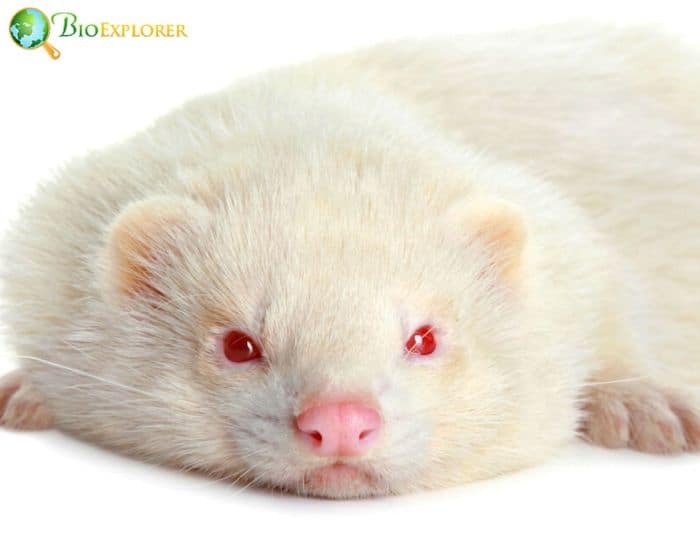
When contemplating the ownership of an Albino Ferret, one cannot bypass the intricate web of legalities that govern pet ownership in various jurisdictions. The laws vary widely, from places where ferret ownership is widely accepted to regions where it is strictly prohibited or regulated.
Overview of Legality Issues:
- Ferret ownership is illegal in certain parts of the world. Some states in the U.S. For instance, they’re banned in places like California, the District of Columbia, and Hawaii[2] due to concerns about becoming invasive if they escape or are released into the wild.
- Even in areas where they are legal, ferrets may still be subject to certain rules and restrictions. This could involve mandatory sterilization, vaccination requirements, or the need for special permits.
- Before acquiring a ferret, you must check local laws and regulations to ensure you can provide a legal and secure home for them.
Special Considerations for Albino Ferrets:
- Regarding the law, Albino Ferrets are typically grouped with other ferrets, and no specific rules usually target them. However, their specific needs, such as sensitivity to light, may necessitate certain accommodations.
- While the legal aspects of owning Albino Ferrets do not significantly differ from those of regular ferrets, the additional care required due to their albinism should be a consideration before deciding to own one.
In essence, whether you can own an Albino Ferret largely depends on local laws and regulations. Potential owners should carefully research these regulations, consult with local animal control authorities, and perhaps even seek legal advice.
The welfare of the ferret must always be the primary concern, and potential owners must be prepared to meet the unique needs of these special pets. It’s a multifaceted decision, laden with responsibilities but also filled with the potential joy that owning such a fascinating creature can bring.
Albino Ferrets as Pets: Pros and Cons
In the pet-owner relationship, Albino Ferrets blends rewards and challenges. This balance shapes the unique experience of owning these different creatures.
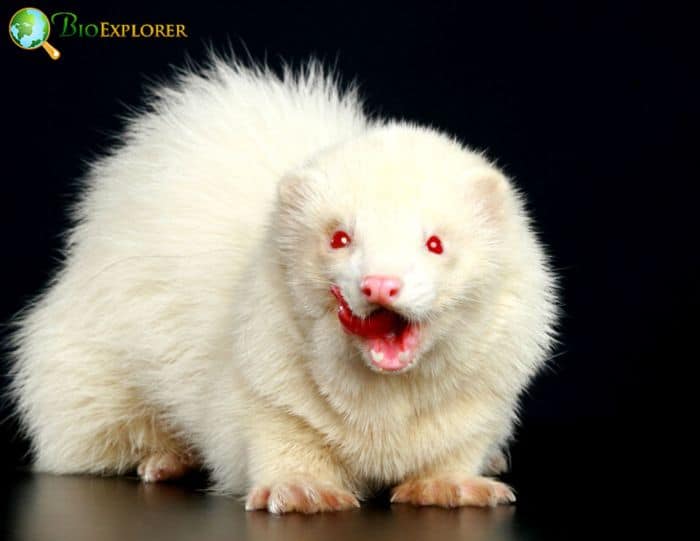
Pros:
- Personality: Albino Ferrets are known for their playful and inquisitive nature. Their lively antics and adorable behaviors can provide endless entertainment and companionship.
- Size: Their small size makes them suitable for apartment living and easy to handle, provided they have enough space to play and explore.
- Uniqueness: The rare, pristine appearance of an Albino Ferret can be quite captivating and sets it apart from other common pets.
Cons:
- Special Needs: The health and care needs of Albino Ferrets can be demanding. Their sensitivity to light and potential for skin issues necessitate extra attention.
- Health Concerns: Ferrets, including Albinos, are prone to certain health conditions such as adrenal disease and insulinoma, which could mean frequent vet visits and potential medical costs.
- Legal Restrictions: As discussed, the legality of owning a ferret varies across regions, and this must be considered.
In essence, Albino Ferrets make lively, engaging pets for those who can cater to their needs and cherish their company. However, their care demands time, dedication, and understanding of their unique health needs. Thus, weighing the pros and cons before inviting one of these furry companions into your life is crucial.
![]()
Adopting an Albino Ferret: Things to Consider
Adopting an Albino Ferret is a major decision requiring careful consideration.

- Reputable Sources: Finding a responsible breeder or adoption center is crucial, ensuring that the ferret has been well-cared for and is in good health. Do your homework, check reviews, and ask for referrals.
- Initial Preparation: Before bringing your Albino Ferret home, ensure their living space is ready. You’ll need a spacious, secure cage, suitable food, toys, grooming tools, and a small pet carrier for vet visits. Also, arrange an initial vet check-up to ensure your new pet is healthy and set up a vaccination and care routine.
Conclusion
Albino Ferrets, with their captivating beauty and dynamic personality, undoubtedly make a unique and engaging pet choice.
In the end, the decision to own an Albino Ferret should be made carefully and thoroughly prepared.
If you can offer a safe, loving home and are prepared to cater to their unique needs, then the delightful world of Albino Ferrets awaits, ready to fill your life with joy and surprise. So, are you ready to embark on this unique pet-owning journey?











